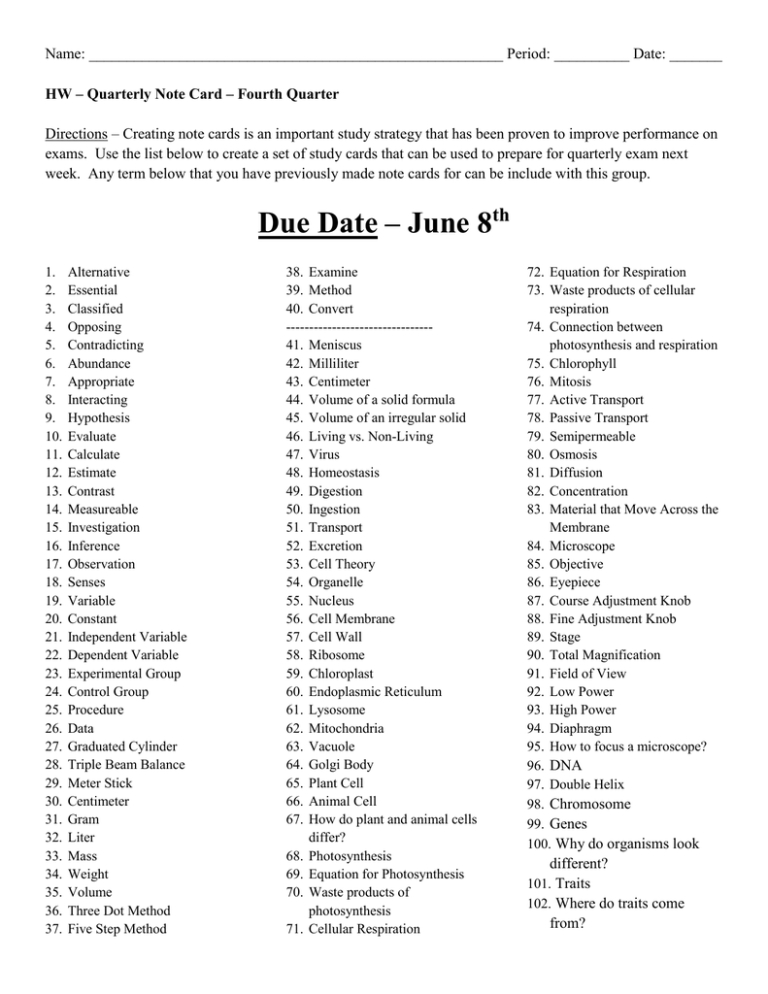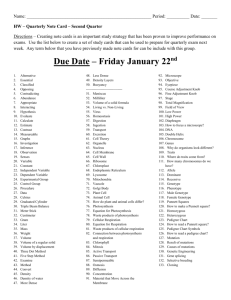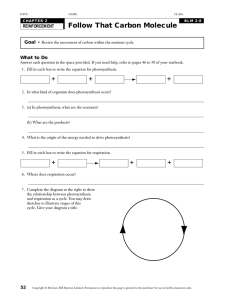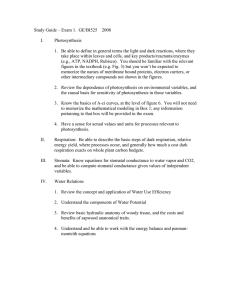Vocabulary Worksheet #4
advertisement

Name: _______________________________________________________ Period: __________ Date: _______ HW – Quarterly Note Card – Fourth Quarter Directions – Creating note cards is an important study strategy that has been proven to improve performance on exams. Use the list below to create a set of study cards that can be used to prepare for quarterly exam next week. Any term below that you have previously made note cards for can be include with this group. Due Date – June 8th 1. 2. 3. 4. 5. 6. 7. 8. 9. 10. 11. 12. 13. 14. 15. 16. 17. 18. 19. 20. 21. 22. 23. 24. 25. 26. 27. 28. 29. 30. 31. 32. 33. 34. 35. 36. 37. Alternative Essential Classified Opposing Contradicting Abundance Appropriate Interacting Hypothesis Evaluate Calculate Estimate Contrast Measureable Investigation Inference Observation Senses Variable Constant Independent Variable Dependent Variable Experimental Group Control Group Procedure Data Graduated Cylinder Triple Beam Balance Meter Stick Centimeter Gram Liter Mass Weight Volume Three Dot Method Five Step Method 38. Examine 39. Method 40. Convert -------------------------------41. Meniscus 42. Milliliter 43. Centimeter 44. Volume of a solid formula 45. Volume of an irregular solid 46. Living vs. Non-Living 47. Virus 48. Homeostasis 49. Digestion 50. Ingestion 51. Transport 52. Excretion 53. Cell Theory 54. Organelle 55. Nucleus 56. Cell Membrane 57. Cell Wall 58. Ribosome 59. Chloroplast 60. Endoplasmic Reticulum 61. Lysosome 62. Mitochondria 63. Vacuole 64. Golgi Body 65. Plant Cell 66. Animal Cell 67. How do plant and animal cells differ? 68. Photosynthesis 69. Equation for Photosynthesis 70. Waste products of photosynthesis 71. Cellular Respiration 72. Equation for Respiration 73. Waste products of cellular respiration 74. Connection between photosynthesis and respiration 75. Chlorophyll 76. Mitosis 77. Active Transport 78. Passive Transport 79. Semipermeable 80. Osmosis 81. Diffusion 82. Concentration 83. Material that Move Across the Membrane 84. Microscope 85. Objective 86. Eyepiece 87. Course Adjustment Knob 88. Fine Adjustment Knob 89. Stage 90. Total Magnification 91. Field of View 92. Low Power 93. High Power 94. Diaphragm 95. How to focus a microscope? 96. DNA 97. Double Helix 98. Chromosome 99. Genes 100. Why do organisms look different? 101. Traits 102. Where do traits come from? 103. How many chromosomes do we have? 104. Allele 105. Dominant 106. Recessive 107. Genotype 108. Phenotype 109. Male Genotype 110. Female Genotype 111. Punnett Squares 112. How to make a Punnett square? 113. Homozygous 114. Heterozygous 115. Pedigree Chart 116. How to read a Punnett square? 117. Pedigree Chart Symbols 118. How to read a pedigree chart? 119. Mutation 120. Result of mutations 121. Causes of mutations 122. Genetic Engineering 123. Gene splicing 124. Selective breeding 125. Cloning -------------------------------------126. Tissue 127. Organ 128. Organ System 129. Organism 130. Skeletal System 131. Why do we have a skeleton? 132. Joints 133. X-ray 134. How do muscles move the skeleton? 135. Nutrients 136. Calorie 137. Carbohydrates 138. Proteins 139. Fats 140. Vitamins 141. Minerals 142. Water 143. Digestive System 144. Physical Digestion 145. Chemical Digestion 146. Why do food particles need to be small? 147. Peristalsis 148. Mouth 149. Esophagus 150. Small Intestine 151. Large Intestine 152. Respiratory System 153. Why do we breathe? 154. Nasal Passage 155. Mucus 156. Trachea 157. Lungs 158. Alveoli 159. Diaphragm 160. Inhale 161. Exhale 162. Lung Capacity 163. Larynx 164. Epiglottis 165. Circulatory System 166. Artery 167. Vein 168. Capillary 169. Measuring Pulse 170. Heart 171. Atria 172. Ventricle 173. Heart Valves 174. Why is a diet high in cholesterol harmful? 175. CPR 176. Blood Pressure 177. Why do we have blood? 178. Function of blood 179. Red Blood Cells 180. White Blood Cells 181. Platelets 182. Plasma 183. How does physical activity affect pulse rate? 184. Blood Type 185. Universal Receiver 186. Universal Donor 187. Immune System 188. Pathogen 189. Contagious 190. 1st Line of Defense 191. 2nd Line of Defense 192. How are white blood cells like an army? 193. Antibodies 194. AIDS 195. HIV 196. Cancer 197. T-Cell 198. How can someone contract AIDS? 199. Causes of cancer 200. Vaccine 201. Nervous System 202. Neuron 203. Neural Impulse 204. Reflex 205. Brain 206. Spinal Cord 207. Medulla 208. Cerebrum 209. Cerebellum 210. Endocrine System 211. Hormone 212. Endocrine Glands 213. Reproductive System 214. Sexual Reproduction 215. Asexual Reproduction 216. Sperm 217. Egg 218. Fertilization 219. Zygote 220. Uterus 221. Fallopian Tube 222. Testis 223. Placenta 224. Umbilical Cord 225. Classification 226. Kingdom 227. Scientific Name 228. Dichotomous Key 229. Classification Chart 230. Ecology 231. Niche 232. Habitat 233. Population 234. Community 235. Ecosystem 236. Biome 237. Biosphere 238. Food Chain 239. Food Web 240. Energy Pyramid 241. Producer 242. Primary Consumer 243. Secondary Consumer 244. Tertiary Consumer 245. Scavenger 246. Decomposer 247. Carnivore 248. Herbivore 249. Omnivore 250. Biotic Factor 251. Abiotic Factor 252. Ecological Succession 253. Climax Community 254. Natural Resource 255. Renewable Resource 256. Non-renewable Resource 257. Fossil Fuel 258. Chlorofluorocarbons (CFC) 259. Ozone Layer 260. Ozone Layer Depletion 261. Danger of Ozone Layer Depletion 262. Greenhouse gasses 263. Greenhouse Effect 264. Global Warming 265. Dangers of Global Warming 266. Alternative Energy Sources 267. Evolution 268. Variation 269. Sources of Variation 270. Adaptation 271. Survival of the Fittest 272. Charles Darwin 273. Natural Selection 274. Atoms 275. Element 276. Electron 277. Proton 278. Neutron 279. Nucleus 280. Atomic Number 281. Atomic Mass 282. Calculating number of protons 283. Calculating number if neutrons 284. Calculating number of electrons 285. Periodic Table 286. Molecule 287. Compound 288. Metal 289. Non-Metal 290. Halogen 291. Nobel Gas 292. Phase of Matter 293. Solid 294. Liquid 295. Gas 296. Phase Change Diagram 297. Melting 298. Freezing 299. Condensation 300. Evaporation 301. Sublimation 302. Centrifuge 303. Physical Change 304. Chemical Change 305. Hints about a chemical change







